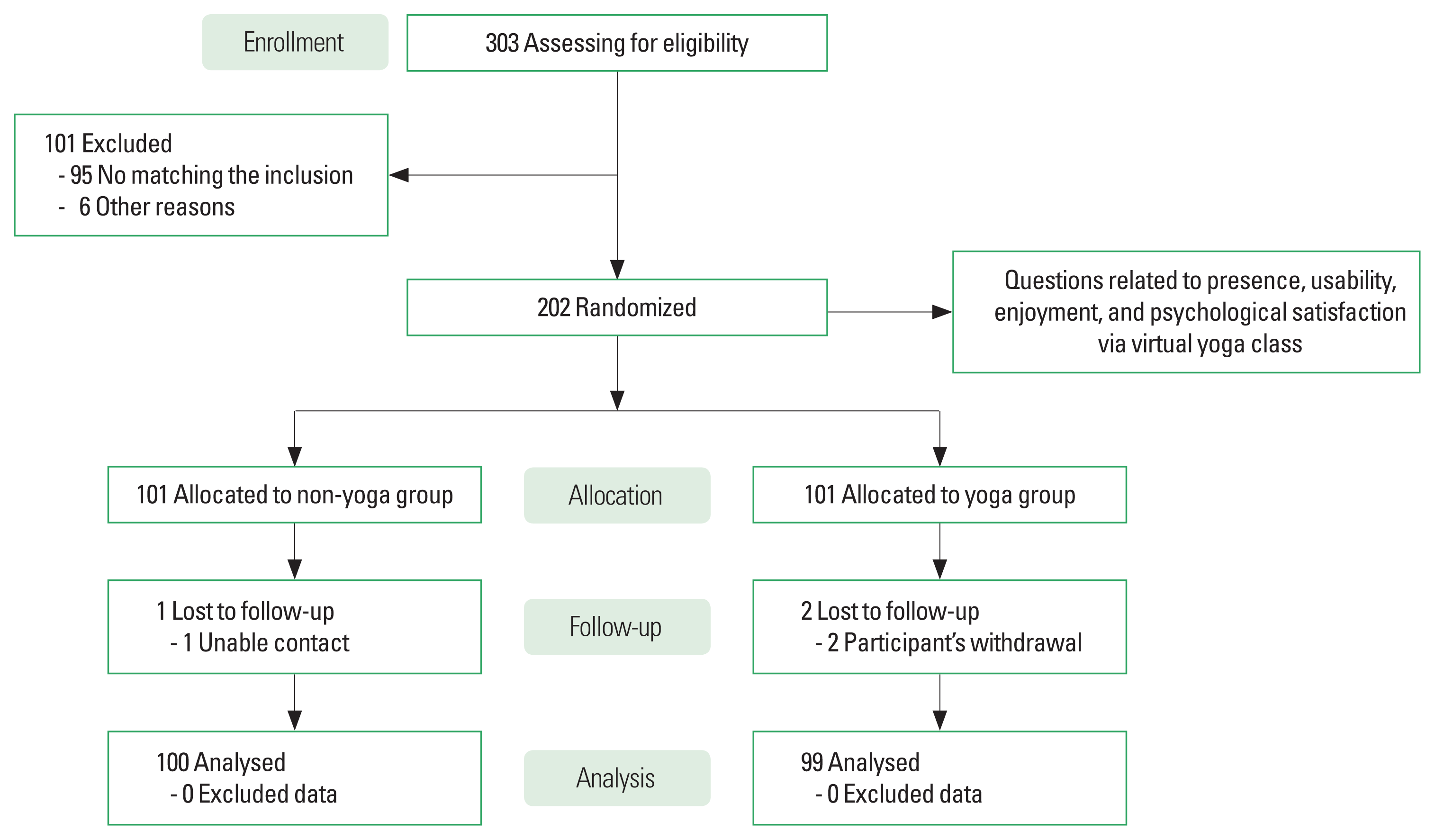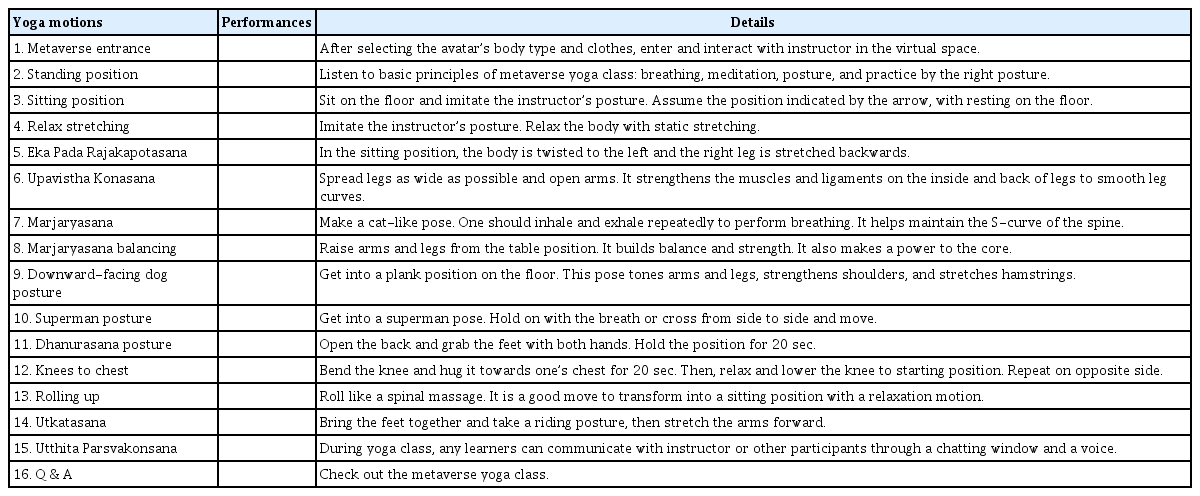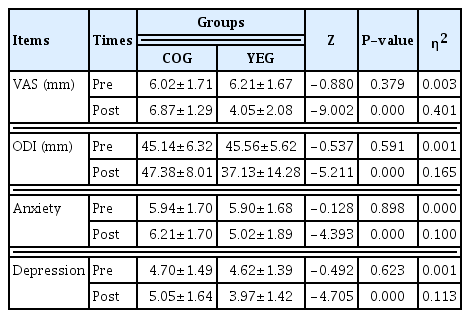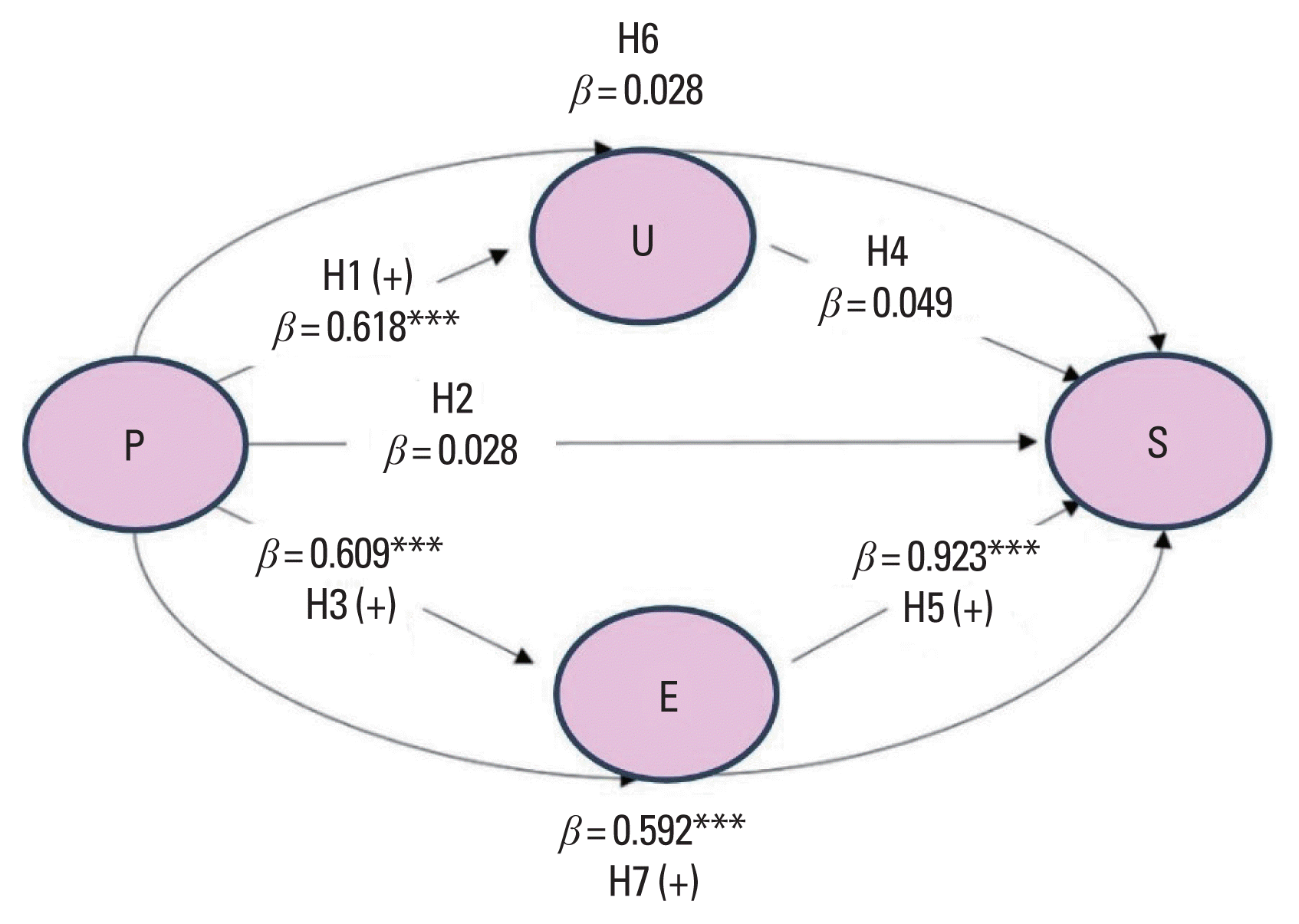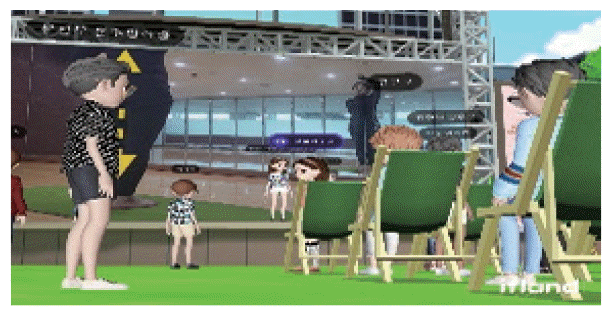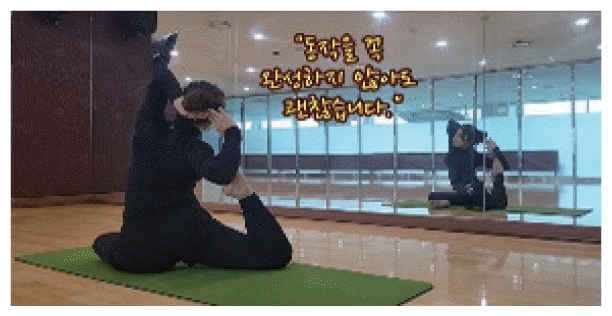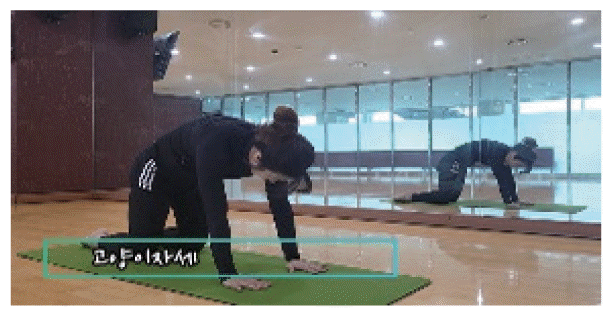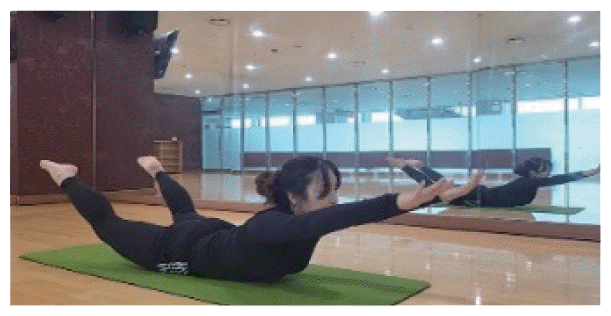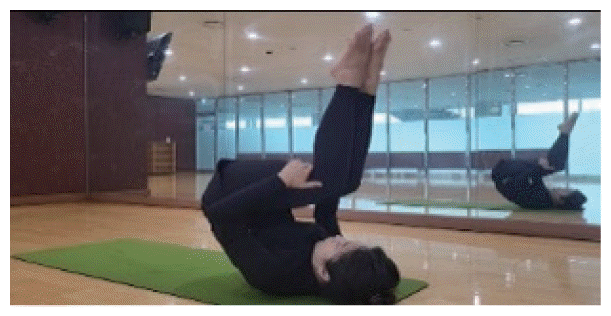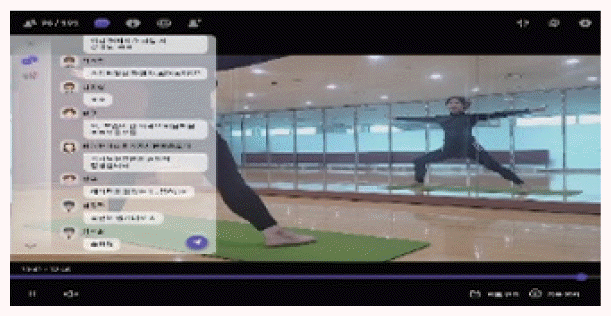Confirmation of the viability of a metaverse yoga class and investigation into the impact on pain, anxiety, and depression associated with low back pain after engaging in virtual yoga sessions
Article information
Abstract
This study aimed to explore the influence of metaverse technology (MT) factors like presence, usability, and enjoyment on patients’ satisfaction, with a focus on examining potential mediating effects. In addition, it sought to assess whether the yoga practice as an intervention therapy in MT induces changes in the pain, anxiety, and depression levels of patients experiencing back pain. From the pool of 202 participants, this study chose participants who had reported enduring low back pain over 12 weeks, with a visual analogue scale (VAS) rating of 4 or higher. After completing the questionnaire, patients were randomly assigned to either the control group (COG, n=100) or the yoga exercise group (YEG, n=99). Results showed that the construct validity for questionnaires and a reasonable model fit were confirmed, and that presence showed a statistically significant effect on psychological satisfaction via the mediating path of enjoyment (β=0.592, P=0.001). Following 8 weeks of the yoga practice, the VAS increased for the COG, while it decreased significantly by ~29% for the YEG (P=0.001). YEG also exhibited a decrease in the Oswestry Disability Index by ~17%, anxiety by ~7%, and depression by ~10% (P=0.001). In conclusion, psychological satisfaction in a yoga practice using a metaverse cannot be achieved solely through the sense of presence; enjoyment is necessary for patients’ satisfaction. Moreover, it was verified that virtual yoga practice is effective in ameliorating psychological factors resulting from back pain.
INTRODUCTION
The national economy is growing, and many technologies are advancing, leading to improved exchange and communication of information (Iivari et al., 2020). Traditional education methods that followed structured classes and evaluations based on set times and locations are being replaced by learner-centred learning methods, tools, and technologies that enable faster collection and sharing of information (Logeswaran et al., 2021). Under the influence of rapidly developing technology, the metaverse-based education is being actively introduced and developed where people can participate and feel like they are in a real environment (Al-Adwan et al., 2023). The coronavirus disease 2019 pandemic has led to a rise in the need for services that can be provided without face-to-face interaction in an unchanged setting (Bradaric and Tresselt, 2022). As the demand for indirect experiences in online virtual space increases, the metaverse technology (MT), which allows for new experiences beyond the boundaries of reality and virtuality, is in the limelight in Korea (Jee, 2023). While the MT used to be primarily associated with internet-based education systems, it has now transformed into a platform that focuses on content-related industries (Al-Adwan et al., 2023). The metaverse has high educational value because it allows one to freely express and produce what one thinks with a sense of challenge (Schmitz et al., 2022). Furthermore, due to the high level of immersion achieved through virtualization, it is possible to facilitate active learning (Fussell and Truong, 2022).
Presence, usability, and enjoyment are identified as key factors that enhance active learning through virtualization. In a nutshell, it is stated that within a particular educational setting, learners prioritize not just their presence but also place significance on the usability and enjoyment of a specific educational program (Sun et al., 2015). To the best of our knowledge, there is a limited number of studies examining the impact of the three factors—presence, usability, and enjoyment—on the psychological satisfaction of learners in the context of using a MT, particularly when the learners are patients. Currently, there is a lack of research on the effectiveness of MT in terms of the type of psychological satisfaction it provides to the subjects. Enhancing psychological satisfaction depends on effectively combining these factors. As a result, learners or patients can feel that what they have learned can be effectively utilized in a metaverse environment similar to actual learning (Riva et al., 2004). The incorporation of an element of enjoyment could potentially enhance the effectiveness of the learning or therapeutic experience (Ehrenberg et al., 2001).
Low back pain (LBP) serves as a significant contributor to physical activity limitations and psychological dissatisfaction in many countries. Despite the absence of a specific pathoanatomical cause for non-specific LBP, the primary focus of treatment is on mitigating pain and its associated consequences. Notably, the control of deep lumbar stabilizing muscles is acknowledged as crucial in addressing this condition (Lara-Palomo et al., 2022). Individuals suffering from LBP often face limitations in their activities of daily living, hindering their ability to engage in functions like walking, running, or other physical activities. This can be especially challenging for instructors involved in teaching physical activity or physical education. Numerous studies conducted thus far indicate that yoga might play a role in alleviating LBP (Williams et al., 2009); however, the exact mechanisms underlying this improvement are still uncertain (Posadzki and Ernst, 2011). Similarly, when virtual education is implemented using the described a MT, the outcomes also appear to be unclear.
Therefore, this study aimed to address two main research objectives. Firstly, it sought to investigate the impact of metaverse technologic factors such as presence, usability, and enjoyment on learners’ satisfaction, along with examining any mediating effects. Simply put, the primary aim was to assess the feasibility of introducing yoga classes in the metaverse—an unexplored online concept—and gauge its potential impact on the participants. Secondly, the study aimed to determine whether the implementation of yoga education as an intervention therapy in metaverse technologic online class brings about changes in the psychological levels of individuals suffering from back pain.
MATERIALS AND METHODS
Participants and research design
The study’s target learners were physical education teachers who attended the “1st grade regular teacher qualification training” program between January 2022 and March 2022. The study targeted only those among all physical education teachers in Korea who were eligible to participate in the program, and the sample size was determined accordingly. The minimum sample size was 137 using the Soper’s online sample size calculator for the structural equation model with a desired power level of 0.8, probability level of 0.05, and anticipated effect size of 0.3 (Soper, 2023; Wolf et al., 2013). The participation criteria for this process were selective, encompassing only individuals who had endured persistent non-specific LBP for a minimum of 12 weeks and had an average pain intensity rating of 4 or higher on a visual analogue scale (VAS) (Ebadi et al., 2012). Conversely, individuals with specific causes of chronic LBP, such as spinal stenosis, were excluded from the study. Out of the total 303 participants, 101 were excluded from this study. This exclusion comprised 95 participants who reported not having back pain and six participants who provided incomplete questionnaire responses as shown in Fig. 1.
After completing the questionnaire, 202 participants (66.7%) with back pain were randomly assigned to either the control group (COG, n=101) or the yoga exercise group (YEG, n=101). During the follow-up process, one participant from the COG and two participants from the YEG were excluded, resulting in the analysis of data from 100 participants in COG and 99 participants in YEG. Demographic characteristics for all participants were shown in Table 1.
This study was designed to validate the viability of online yoga classes and to observe psychological changes in a group of randomly selected participants with back pain who underwent eight weeks of online yoga sessions. The YEG participated in the program, engaging in yoga practice using their personalized avatars in their designated space for 50 min a day, 3 days a week, over the course of 8 weeks. In contrast, the COG did not partake in yoga practice but was permitted to watch educational programs concurrently. This study was approved by the Human Studies Committee at the College of Health Science at Hanseo University (HS22-12-01). All participants were required to read and sign an informed consent form before their involvement in the study.
Data collection and instrument
For this study, surveys used in previous studies were modified and employed in alignment with the objective of this study. The objective of this study was to investigate investigated the impact of three factors, presence, usability, and enjoyment, on the learners’ satisfaction in a virtual yoga class by utilizing the technology acceptance model (Mailizar et al., 2021). This approach has been previously validated and evaluated in research, demonstrating its robustness (Cabero-Almenara et al., 2019). The questionnaires are listed in Supplementary Table 1, which each item was evaluated on a 5-point Likert scale ranging from 1 for “strongly disagree” to 5 for “strongly agree.” Cronbach coefficient α values for presence, usability, enjoyment, and educational satisfaction were 0.916 for presence, 0.897 for usability, 0.962 for enjoyment, and 0.967 for psychological satisfaction, respectively.
Intervention procedure
As participants, physical education teachers with LBP participated in a virtual yoga class as avatars using Ifland (SK Telecom, Seoul, Korea), one of the commercialized metaverse platforms in Korea, whose functions are similar to the existing metaverse platforms. During the metaverse yoga class, after entering their avatars, the participants were given instructions on how to use the menus and functions of the program, and then the yoga program began as shown in Table 2. Throughout a virtual yoga class, the YEG had the ability to open a microphone and speak at any time, as well as communicate through a chat window. Additionally, they could use emoticons and control their avatars’ movements to express various emotions. The fundamental concepts of metaverse yoga class were the same as traditional yoga, which included postures (asanas), breathing, and meditation. This implies that while executing different yoga postures, individuals could practice exercises to concentrate on their inner selves while continuously taking deep breaths through their abdominal muscles, even if they were not able to maintain the perfect yoga posture. They could see the effect of exercise by maintaining movement within a range of motion possible for everyone. In the metaverse setting, photos or video materials could be used to add descriptions or communicate with others. Participants assessed their levels of pain, anxiety, and depression through online ratings both before and after the virtual yoga class.
Pain degree measures
To gauge the level of pain, the investigation utilized the VAS to identify variables associated with body movements, nocturnal pain, pain experienced while lying down or standing, and waist tension. Participants assessed their back pain using a bipolar rating scale presented in a rectangular box measuring 10 cm by 5 cm. The scale ranged from “0” indicating no pain to “10” representing intense pain. All participants marked their pain level on the scale, and a numerical score was determined by overlaying a transparent sheet. Additionally, participants completed the Oswestry Disability Index (ODI) questionnaire, scored on a scale of 0 to 100 percentage points, with higher scores indicating greater impairment (Ruiz et al., 2014). The ODI, a commonly employed tool for assessing spinal disorders (Deyo et al., 1998; Fairbank and Pynsent, 2000), comprises ten sections measuring pain levels and the extent to which it hampers various physical activities. The questionnaire, known for its reliability and validity in evaluating functional ability in individuals with spinal disorders (Kim et al., 2005), underwent evaluation by psychologists at the study’s commencement and conclusion (Jee, 2018). The internal consistency of the VAS and ODI, as represented by Cronbach, was calculated, resulting in values of 0.877 and 0.885, respectively.
Anxiety and depression measures
In evaluating anxiety and depression levels, the study employed the VAS to identify factors linked to experiencing anxiety due to back pain. Participants gauged their anxiety associated with back pain using a bipolar rating scale presented in a rectangular box measuring 10 cm by 5 cm. The scale ranged from “0,” indicating no anxiety (I am consistently anxious due to my back pain) or no depression (I’m always depressed because of my back pain), to “10,” representing intense anxiety (I am not anxious at all due to my back pain) or severe depression (I am not depressed at all by my back pain). Subjects indicated their anxiety level on the scale, and a numerical score was determined by overlaying a transparent sheet.
Data analysis
Statistical analyses were performed using IBM SPSS Statistics ver. 25.0 (IBM Co., Armonk, NY, USA) and AMOS (ver. 23.0; SPSS Inc., Chicago, IL, USA). First, frequency and descriptive analyses were conducted. Second, this study examined the relationships among presence, usability, enjoyment, and satisfaction. Third, the reliability of the items constituting the factors was examined using the Cronbach α coefficient. Fourth, confirmatory factor analysis was performed for the validity of the observed latent variables. Convergent and discriminant validity was established. Fifth, the structural equation model analysis was performed to confirm both direct and indirect effects between the variables. To verify the significance of the indirect effects, bootstrap analysis was conducted using phantom variables. Microsoft excel (Microsoft, Redmond, WA, USA) was also utilized for data analysis, with results expressed as mean±standard deviation. Group differences were examined using nonparametric Mann-Whitney U-test. Additionally, a delta percentage (%) analysis was carried out, and the effect size (η2) was calculated based on Cohen d (Cohen, 1992). The predetermined significance level was set at P≤0.05 for all analyses.
RESULTS
Descriptive statistics, correlation analysis, and discriminant or convergent validity
As shown in Supplementary Table 2, the skewness and kurtosis were calculated to determine whether the assumption of normality of the variables was satisfied. If the skewness was less than the absolute value of 3 and the kurtosis was less than the absolute value of 10, it was judged to be close to a normal distribution. All variables appeared to satisfy the assumption of normality. Pearson correlation coefficient (r) was computed to assess the correlation between presence, usability, enjoyment, and educational satisfaction prior to conducting the structural equation modelling analysis. All variables exhibited statistically significant correlation coefficients (P<0.001). Presence demonstrated a significant positive correlation with usability (r=0.695), enjoyment (r=0.698), and educational satisfaction (r=0.686). Usability showed significant positive correlations with enjoyment (r=0.902) and educational satisfaction (r=0.872). Enjoyment demonstrated a significant positive correlation with educational satisfaction (r=0.936). To examine construct validity, the discriminant and convergent validity of presence, usability, enjoyment, and educational satisfaction were analysed. All four reported the average variance extracted (AVE) was >0.50, which was considered to be adequate for convergent validity. Their composite reliability (CR) values, the factor loading of the indicator, also were >0.70. In addition to, in this study, the discriminant validity was achieved when the minimum AVE value (0.622) was greater than the maximum squared correlation coefficient value between latent variables as shown in Supplementary Table 3.
Goodness-of-fit test of research model and confirmatory factor analysis
Before conducting the structural equation modelling analysis, the goodness-of-fit of the measurement model was assessed using confirmatory factor analysis to determine whether the observed variables adequately explained the latent variables. The fitness of the measurement model was assessed using the χ2 (DF=45) test, which yielded a value of 372.454 (P<0.001). Other goodness-of-fit indices including the incremental fit index, Tucker-Lewis index, comparative fit index, and the root mean square error of approximation were evaluated, and their values were 0.901, 0.854, 0.899, and 0.047, respectively. These results indicate that the measurement model is relatively suitable in accordance with the criteria described in previous studies (Yang et al., 2010). Confirmatory factor analysis was performed to establish the validity of the scale as shown in Supplementary Table 4. All factor loading values exceeded 0.5 at the statistically significant level, and the criteria for convergent validity were met by satisfying the requirements of CR >0.7 and AVE >0.5, indicating that the validity of the scale was established.
Hypotheses’ verification via path analysis and mediation effect
To confirm the degree of impact of three factors set in this study on the learners’ satisfaction, path analysis was performed, and the results were shown in Supplementary Table 5. When conducting path analysis for this research model, only hypotheses H1, H3, and H5 were confirmed, while hypotheses H2 and H4 were not supported. As shown in Fig. 2, the findings indicated that H1, which tested the impact of presence on usability, had a statistically significant positive effect. In contrast, H2, which examined the effect of presence on educational satisfaction, did not yield a statistically significant effect. While H3 demonstrated a significant positive impact of presence on enjoyment, H4 did not establish any statistically significant effect of usability on educational satisfaction. Finally, H5, which investigated the effect of enjoyment on educational satisfaction, indicated a statistically significant positive effect. A bootstrapping test was carried out to verify the significance of the mediating effect. The path analysis results indicated that the impact of usability on educational satisfaction was not significant (β=0.049), and the impact of usability as mediating variable for presence was not significant (β=0.028, H6). The results also showed that presence had a statistically significant effect on both usability and enjoyment (β=0.618 and β=0.609; P< 0.001). In addition, presence showed a statistically significant effect on educational satisfaction through enjoyment as mediating variable (β=0.592).

Results of path analysis of the research model. H1, presence (P) of a virtual yoga class will have a significant positive effect on usability (U); H2, P of a virtual yoga class will have a significant positive effect on satisfaction (S); H3, P of a virtual yoga class will have a significant positive effect on enjoyment (E); H4, U of a virtual yoga class will have a significant positive effect on S; H5, E of a virtual yoga class will have a significant positive effect on S; H6, U will play a mediating role in the relationship between P and S; H7, E will play a mediating role in the relationship between P and S.
Exploration of pain, anxiety, and depression related to LBP following virtual yoga practice
Table 3 displayed the pre-experiment levels of heart rate, VAS, ODI, anxiety, and depression, indicating that there were no significant differences between the groups. Following the experiment, there was a tendency for an increase in heart rate in the COG, while it tended to decrease in the YEG. The VAS showed a tendency to increase in the COG, while in the YEG, it tended to decrease. Similarly, the ODI exhibited a tendency to increase in the COG and decrease in the YEG. On the psychological front, anxiety tended to increase in the COG, but it showed a tendency to decrease in the YEG. Additionally, depression tended to increase in the COG, while in the YEG, there was a tendency for it to decrease.
As indicated by the delta percentage in Fig. 3, the VAS registered 28.80%±81.43% for COG, while it was −28.54%±44.77% for YEG (P=0.001, η2=0.161). For the ODI, the values were 6.74%±22.38% in COG and −17.30%±32.54% in YEG (P= 0.001, η2=0.158). Anxiety levels were 14.38%±55.15% in COG, compared to −7.44%±51.19% in YEG (P=0.001, η2=0.041), and depression levels were 17.27%±54.02% in COG, whereas they were −9.58%±33.35% in YEG (P=0.001, η2=0.083).
DISCUSSION
This study revealed that 66.7% of physical education teachers in Korea report experiencing back pain. The outcomes of assessing the viability of applying yoga education to them in virtual reality and the results after 8 weeks of virtual yoga practice are as follows. Firstly, the construct validity of measurement for presence, usability, and enjoyment was confirmed through discriminant and convergent validity, and the structural equation model analysis confirmed the suitability of the research model. Based on the research model, this study’s hypotheses show that while H1 and H3 suggest a positive impact of presence on usability and enjoyment, respectively, H2 indicates that presence itself does not have a significant influence on psychological satisfaction. As seen in H4, usability does not significantly affect psychological satisfaction, but H5 reveals that enjoyment directly influences the satisfaction. The results of H6, which examined the mediating effects of variables, indicate that presence does not have a positive impact on the satisfaction through usability. As shown in H7, however, presence was found to have a positive impact on psychological satisfaction through enjoyment. The presence should make a video feel very natural so that the distinction between the virtual world and the real one can be naturally connected through realism and immersion (Weber et al., 2021). In the context of the metaverse environment, usability refers to the degree to which learners believe that the productivity or efficiency of a task will be enhanced by using a particular system or technology and their performance (Bork et al., 2019). Usability means that learners perceive the information system they use for their studies as appropriate and useful for task performance (Alyoussef, 2023). On the other hand, enjoyment refers to a voluntary and active emotional state in which people experience spontaneous interest and enjoyment without expecting a reward (Lee et al., 2023).
It is also defined as an immediate and enjoyable experience gained by doing something. During the pandemic, there has been a widespread acceptance of the MT for virtual collaboration, with platforms like Zoom and Teams becoming the customary mode for colleagues to interact. As a result, we are now collectively acquainted with the concept of selecting an on-screen representation or avatar (Kye et al., 2021). Presence of the MT refers to the feeling of being immersed in a virtual world, where the users or learners perceive a sense of presence as if they were physically present in that space. In more intricate organisms like humans, the faculty of presence has developed to discern external events that are perceived from imagined events (Buckner and Carroll, 2007). Riva et al. (2004) suggested that presence can be achieved not only when information is presented through all human sensory organs, but also when the user focuses on specific sensory information. This means that even if virtual environments do not provide users with all types of sensory information as in the real world, users can still experience a sense of reality. Presence in the metaverse environment should provide a natural and immersive experience that gives a sense of reality, and higher presence can be achieved when the brain thinks accurately as in real life (Schöne et al., 2023). Learning satisfaction, one of the learning outcomes, refers to the degree of achievement experienced by learners as they satisfy their learning desires, perceive harmonious relationships with teachers, and recognize differences in perceptions between their living environments and learning. Systematic understanding of learners’ educational experiences through satisfaction is essential for the qualitative growth of education, and this does not differ significantly from the conditions in the metaverse environment. In this context, educational satisfaction is defined as the subjective evaluation of learners regarding various educational experiences and achievements (Lewis et al., 2011), and is not limited to experiences directly related to “educational activities.” Rather, it is reported to be formed by a combination of learners’ mental, social, physical, and other experiences (Elias and Weissberg, 2000). Gurpinar et al. (2010) explained satisfaction as the learner’s evaluation of educational experiences and outcomes, which is based on the comparison between expectations and actual achievements. The factors that influence educational satisfaction in the metaverse environment can be numerous, but this study chose presence, usability and enjoyment as influencing factor. In the results of the path analysis, enjoyment showed a statistically significant direct effect and the highest path coefficient (H5; β=0.923, P<0.001). On the other hand, the direct effects of the other two factors, presence and usability, were not statistically significant. Interestingly, presence showed a statistically significant effect on educational satisfaction through the mediating path of enjoyment (H7; β=0.592, P=0.001), although it did not have a significant effect on educational satisfaction directly (H2; β=0.028, P=0.433). These results in this study showed that presence of the MT alone could not satisfy learners’ satisfaction in a yoga class, even if previous studies reported that presence improved learning outcomes, including satisfaction, by providing the reality and increasing learners’ interest.
Secondly, it was noted that engaging in yoga practice, designed with consideration for the specified requirements in virtual yoga education, yielded highly positive outcomes for the participants. Based on the research model, after 99 teachers with back pain engaged in virtual yoga practice 3 days a week (Monday, Wednesday, Friday) for 8 weeks, a notable reduction in pain levels was observed, as indicated by significant decreases in the VAS and ODI. Moreover, virtual yoga practice led to a significant reduction in anxiety and depression stemming from chronic back pain. To put it differently, the authenticity of virtual yoga, providing a sense that the class is genuinely occurring, proves effective in enhancing learning performance and fostering learners’ interest in the educational process, as noted by Ehrenberg et al. (2001). This finding aligns with previous studies that also reported similar outcomes, as observed in studies such as those by Abdel Meguid et al. (2022). Experiencing a sense of presence in virtual reality gives rise to feelings of movement, excitement, and pleasure, with enjoyment emerging as the most prominent psychological impact of presence (Beverly et al., 2021). Some studies have also reported that experiencing a high level of the presence results in greater enjoyment and interest (Makransky and Mayer, 2022). Similarly, Lee et al. (2023) conducted a study to investigate how avatar identification, social participation, and avatar customization affect users’ enjoyment of the metaverse. Their findings indicate that social participation plays a mediating role in the relationship between avatar identification and enjoyment of participating in the metaverse. The findings imply that engaging in yoga practice using an avatar, as conducted in this study, had the potential to enhance educational outcomes. This was substantiated by the observed improvement in negative psychological factors associated with back pain following the practice. In fact, yoga has long been known to provide positive psychological and physical effects. In this regard, Tilbrook et al. (2011) reported that 93 patients attended offered yoga at least three of the first six sessions and at least three other sessions. They confirmed that offering a 12-week yoga program to adults with chronic or recurrent LBP led to greater improvements in back function than did usual care. This study allowed us to observe that implementing this therapeutic strategy is feasible through virtual reality. The usability and enjoyment elements, crucial parameters for primary presence and psychological satisfaction in virtual reality program construction, were further enhanced. This underscores the importance of emphasizing these aspects in the development of virtual reality programs.
The reason why the use of the metaverse for virtual classes is not rapidly spreading may be due to doubts that it cannot directly provide the goals of yoga practice such as health promotion, physical fitness enhancement, stress relief, cooperative spirit development, interest stimulation, and motor skill development that have usually performed in traditional classes (Yu et al., 2022). In fact, it may be because the design of the virtual physical activity classes using the MT is perceived as complex and difficult compared to the typical education curriculum. In fact, maintaining the same goals in the metaverse environment or creating educational plans using the MT requires a high level of technological and content knowledge, so it may be difficult to accept this realistically (Moro et al., 2017). The world is rapidly changing, and there is no doubt that the educational or therapeutic environment is changing as well. Considering that the metaverse is expected to become a more central part of the educational environment in the future, educators or therapist need to form an understanding of the metaverse utilization through various immersive lessons and seek ways to use it educationally. This study confirmed that educational satisfaction in yoga class using the MT cannot be satisfied only with the sense of presence, the reality of performing physical activity, and the enjoyment through physical activity is necessary for learners’ satisfaction even in the virtual environment. Therefore, further research for identifying factors that influence learners’ educational satisfaction are needed to actively utilize the metaverse in a yoga practice. Additionally, the study only focused on one application, a metaverse yoga class, which may limit the generalizability of the results. In other words, it is hoped that a variety of yoga class programs will be blended with various metaverse technologies to explore better educational outcomes.
SUPPLEMENTARY MATERIALS
Supplementary Tables 1–5 can be found via https://doi.org/10.12965/jer.2346586.293.
Supplementary Table 1.
Questions related to presence, usability, enjoyment, and psychological satisfaction of virtual yoga class
Supplementary Table 2.
Descriptive statistics of main variables
Supplementary Table 3.
Discriminant and convergent validities
Supplementary Table 4.
Results of convergent validity and factor loading
Supplementary Table 5.
Results of path analysis of the research model
ACKNOWLEDGMENTS
This research was supported by Basic Science Research Program through the National Research Foundation of Korea (NRF) funded by the Ministry of Education (NRF-2022S1A5B5A16056492).
Notes
Supplementary Tables 1–5 can be found via https://doi.org/10.12965/jer.2346586.293.
CONFLICT OF INTEREST
No potential conflict of interest relevant to this article was reported.

